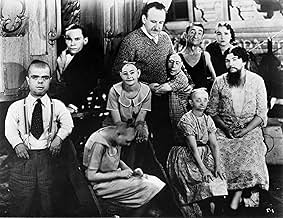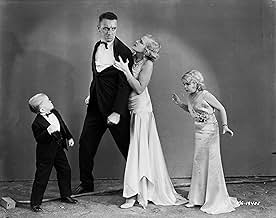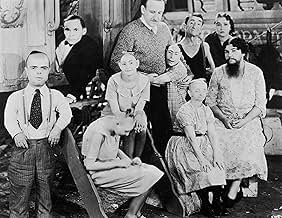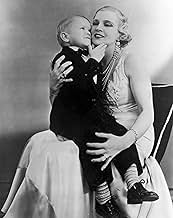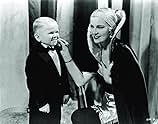IMDb RATING
7.8/10
53K
YOUR RATING
A circus' beautiful trapeze artist Cleopatra agrees to marry Hans the leader of side-show performers, but Hans' deformed friends discover that she is only marrying him for his inheritance. S... Read allA circus' beautiful trapeze artist Cleopatra agrees to marry Hans the leader of side-show performers, but Hans' deformed friends discover that she is only marrying him for his inheritance. So they seek revenge.A circus' beautiful trapeze artist Cleopatra agrees to marry Hans the leader of side-show performers, but Hans' deformed friends discover that she is only marrying him for his inheritance. So they seek revenge.
- Awards
- 2 wins & 1 nomination total
Roscoe Ates
- Roscoe
- (as Rosco Ates)
Prince Randian
- The Living Torso
- (as Rardion)
Featured reviews
In the first place, this movie was originally made to compete with the Universal Horror films, as though these human beings who are the titular "freaks" are not human. Director Tod Browning was still reeling from the loss of his big star, Lon Chaney, to cancer, and thought this would be a good follow up to his previous horror films without Chaney. And after all, he had just finished directing Dracula.
Actually, it paints a very sympathetic picture of the disabled and deformed circus performers, who, at this time of limited medical knowledge and abounding prejudice, were very limited in what they could do in life. They have a very deep camaraderie that is shown through such events as the birth of a child to the bearded lady and the engagement of one of the conjoined twins. Since the other twin is already married, there is much arguing over what the logistics are going to be in these two marriages.
The actual "monsters" in this film are the acrobat "Cleopatra" (Olga Baclanova), and strong man Hercules (Henry Victor), who are having an affair. Two physical specimens with monstrous morality. When the dwarf Hans is captivated by Cleopatra's beauty, she at first teases him by leading him on. But then he starts giving her expensive jewelry and she decides to keep up the ruse. When Freida, Hans' dwarf girlfriend, comes to Cleopatra and asks her to stop teasing him, she accidentally tips off Cleo to the fact that Hans has inherited a great fortune. Hercules and Cleo then plan to get Hans to marry Cleo and then poison him so she can inherit his money. But the two don't realize the close strong bond that the circus performers have with one another and that they are literally each others eyes and ears. Complications ensue.
The film was originally set to run at 90 minutes, but test audiences were so revolted that 30 minutes were cut out so that the remaining film only runs at an hour. Then a scene was tacked on at the end to show Hans' grief over what has ultimately happened. MGM would often add an end scene that really didn't fit the mood of the rest the film during Irving Thalberg's reign there to wrap things up.
This film pretty much finished the career of director Browning as afterwards he only directed a farcical sound remake of a silent film he had made at MGM and one other film and then retired. This was a good late role for Olga Baclanova. She had a very thick Russian accent and had some great late silent roles at Paramount, but talking film had not been kind to her career. This really gave her one last great role where her accent really fit into the plot, plus this was not a film where lots of dialogue was called for, and she was very good at using gestures and expressions to convey emotion.
In the 1960s this film got a fresh look, and today is widely celebrated as having been ahead of its time. The horror is implied and left up to your imagination as to just HOW it happened, and the empathy shown the circus performers is profound. It even got a separate DVD release with commentary.
Actually, it paints a very sympathetic picture of the disabled and deformed circus performers, who, at this time of limited medical knowledge and abounding prejudice, were very limited in what they could do in life. They have a very deep camaraderie that is shown through such events as the birth of a child to the bearded lady and the engagement of one of the conjoined twins. Since the other twin is already married, there is much arguing over what the logistics are going to be in these two marriages.
The actual "monsters" in this film are the acrobat "Cleopatra" (Olga Baclanova), and strong man Hercules (Henry Victor), who are having an affair. Two physical specimens with monstrous morality. When the dwarf Hans is captivated by Cleopatra's beauty, she at first teases him by leading him on. But then he starts giving her expensive jewelry and she decides to keep up the ruse. When Freida, Hans' dwarf girlfriend, comes to Cleopatra and asks her to stop teasing him, she accidentally tips off Cleo to the fact that Hans has inherited a great fortune. Hercules and Cleo then plan to get Hans to marry Cleo and then poison him so she can inherit his money. But the two don't realize the close strong bond that the circus performers have with one another and that they are literally each others eyes and ears. Complications ensue.
The film was originally set to run at 90 minutes, but test audiences were so revolted that 30 minutes were cut out so that the remaining film only runs at an hour. Then a scene was tacked on at the end to show Hans' grief over what has ultimately happened. MGM would often add an end scene that really didn't fit the mood of the rest the film during Irving Thalberg's reign there to wrap things up.
This film pretty much finished the career of director Browning as afterwards he only directed a farcical sound remake of a silent film he had made at MGM and one other film and then retired. This was a good late role for Olga Baclanova. She had a very thick Russian accent and had some great late silent roles at Paramount, but talking film had not been kind to her career. This really gave her one last great role where her accent really fit into the plot, plus this was not a film where lots of dialogue was called for, and she was very good at using gestures and expressions to convey emotion.
In the 1960s this film got a fresh look, and today is widely celebrated as having been ahead of its time. The horror is implied and left up to your imagination as to just HOW it happened, and the empathy shown the circus performers is profound. It even got a separate DVD release with commentary.
D-U-M-B! Everyone's accusin' me!
I've been listening to The Ramones' music off and on for almost 30 years now, and despite reading and viewing tons of stuff about the band and its origins, I'd never run across how they came up with the whole "pinhead" theme.
Well, I've finally seen FREAKS, often listed as one of the great cult flicks of all time. And wouldn't you know it, the "pinheads", including "Schlitze", the inspiration for The Ramones' mascot who always came out to join the band during their live shows at the end of the Pinhead song, were in FREAKS.
The Ramones also slightly modified the "freak chant" from the wedding scene, changing "Gooble-Gobble" to "Gabba-Gabba". I guess Jeffrey Hyman (Joey Ramone) must have viewed himself as somewhat "freakish" (he did have an incredible look), and really related to the group of circus curiosities assembled for this film.
After being shelved for about three decades, FREAKS started playing again at art-house theaters in the mid-60's, and that's where Joey had to have come across it.
As far as my film review, this movie needs to be viewed. Look past the stilted acting, and soak up the message. It will stay with you for a long, long time.
I've been listening to The Ramones' music off and on for almost 30 years now, and despite reading and viewing tons of stuff about the band and its origins, I'd never run across how they came up with the whole "pinhead" theme.
Well, I've finally seen FREAKS, often listed as one of the great cult flicks of all time. And wouldn't you know it, the "pinheads", including "Schlitze", the inspiration for The Ramones' mascot who always came out to join the band during their live shows at the end of the Pinhead song, were in FREAKS.
The Ramones also slightly modified the "freak chant" from the wedding scene, changing "Gooble-Gobble" to "Gabba-Gabba". I guess Jeffrey Hyman (Joey Ramone) must have viewed himself as somewhat "freakish" (he did have an incredible look), and really related to the group of circus curiosities assembled for this film.
After being shelved for about three decades, FREAKS started playing again at art-house theaters in the mid-60's, and that's where Joey had to have come across it.
As far as my film review, this movie needs to be viewed. Look past the stilted acting, and soak up the message. It will stay with you for a long, long time.
Don't let people convince you that "Freaks" is a horror movie, because it isn't. It's actually a quite sad and sympathetic look at the way abnormalities were treated in the early part of the 20th century, and has direct parallels to the obsession with physical perfection causing eating disorders today. Tod Browning of course asks us to consider who are the bigger freaks: those with deformed bodies or those with deformed souls? The two "normal" people who are out to cheat and steal are monstrous, whereas the freaks are quite likable and charming. The ending is disturbing to be sure, but it's hard to condemn the freaks for acts that seem largely justified.
Is it a coincidence that in several shots showing Cleopatra reclining on a sofa, she appears to be deformed herself (in one shot it looks as if she has no legs). Has anybody else noticed this? "Freaks" was obviously way ahead of its time. There's a very interesting documentary on the DVD about its reception in 1932; it bombed and pretty much ruined Browning's career. Thank God that the general public is not allowed to be the final arbiter of a film's value. Think how many priceless films we would have lost by now if that were the case.
Grade: A
Is it a coincidence that in several shots showing Cleopatra reclining on a sofa, she appears to be deformed herself (in one shot it looks as if she has no legs). Has anybody else noticed this? "Freaks" was obviously way ahead of its time. There's a very interesting documentary on the DVD about its reception in 1932; it bombed and pretty much ruined Browning's career. Thank God that the general public is not allowed to be the final arbiter of a film's value. Think how many priceless films we would have lost by now if that were the case.
Grade: A
Part fictional portrait of a group of circus sideshow performers and part tragic soap opera about their various and complicated relationships, the main story has a midget, Hans (Harry Earles), falling in love with the Amazonian trapeze artist, Cleopatra (Olga Baclanova), who feigns affection for him--at first to taunt him and later to use him.
Freaks isn't really a horror film, although the horror boom that began in 1931 precipitated Freaks entering production. The script developed out of an earlier one named "Spurs" that had been in MGM's possession since the late 1920s. The success of Universal's horror films of 1931 (Dracula and Frankenstein) had studios scrambling to cash in on the trend. Horror films weren't new, of course, but repeated commercial success of horror films released in quick succession was. A number of factors contributed to the phenomenon, including the Great Depression, the lingering cultural impact from World War I, and the advent of sound films. So even though Freaks wasn't exactly horror, and the protagonists weren't exactly monsters, it was close enough. In the early 1930s, the public had not yet been overexposed to media-sensationalized differences in human appearances and behavior. The effect of the film then, in conjunction with memories of real life horrors, including those of war-mangled veterans, offered the emotional reaction that producers and studios are often seeking from horror films.
But Freaks is really part tragic drama, part character study, and in many ways it is almost a documentary. The modern attraction to the film comes from a few sources. One, the "gawking effect", or the simple fact of watching the freaks in action. Sideshows are an unfortunately dying phenomenon, if they're not already dead (many would say they are), largely because of a combination of medical advances, which often "cure" the physical differences that would have made "victims" sideshow candidates, and political correctness, which mistakenly sees sideshows as negatively exploitative. It's fascinating watching the different kinds of people in the film and their behavior, including not only their social interactions, but how some of them manage to just get around and perform everyday activities such as eating, lighting a cigarette, and so on. This kind of material takes up at least half of the film's short running time (64 minutes; initially it ran closer to 90 minutes, but 26 minutes of cuts were made (and are now apparently lost) to appease the New York State censor board).
Two, this was a lost film, figuratively and almost literally, for quite some time. MGM wanted nothing to do with it. For a while, it had been playing the "roadshow" circuit in different cuts, under different titles, such as "Nature's Mistakes". The film had been banned in many areas, and at least technically is still banned in some. It eventually appeared on VHS in the 1980s, but until the recent DVD release, it has never been very easy to find in most rental or retail outlets.
Three, the most common modern reading of the film--and this was also part of director Tod Browning's intention in making Freaks, even if the average audience member didn't see it this way at first, has it as a Nightbreed (1990)-like turning of the dramatic tables, where the extremely alienated "monsters" are the sympathetic protagonists and the ostensibly "normal" humans turn out to be the real monsters. For those who like films best where they can identify in some emotional way with the characters, Freaks is particularly attractive to anyone who feels alienated or strongly different, even looked down upon, by "normal" society. At various times, and by various people, Freaks has been read as everything from purely exploitative schlock to a socialist parable to a film imbued with odd commentary, metaphors and subtexts about male-female couplings and Oedipal complexes.
Freaks isn't a great film in terms of the usual criteria, such as storytelling, exquisite performances, and so on, but it's appropriate that it wouldn't be a masterpiece per the normal criteria--it's not about normal people. The film is certainly valuable as a creative, almost experimental artwork, not to mention as a more or less permanent record of the decayed and almost abandoned artform of sideshows. It's not surprising that not every cast member is an incredible actor--for many roles, there was only one person available who could have fulfilled the character in a particular way, making the stilted delivery of dialogue more excusable. In any event, this is an important film historically, and a joy to watch.
Freaks isn't really a horror film, although the horror boom that began in 1931 precipitated Freaks entering production. The script developed out of an earlier one named "Spurs" that had been in MGM's possession since the late 1920s. The success of Universal's horror films of 1931 (Dracula and Frankenstein) had studios scrambling to cash in on the trend. Horror films weren't new, of course, but repeated commercial success of horror films released in quick succession was. A number of factors contributed to the phenomenon, including the Great Depression, the lingering cultural impact from World War I, and the advent of sound films. So even though Freaks wasn't exactly horror, and the protagonists weren't exactly monsters, it was close enough. In the early 1930s, the public had not yet been overexposed to media-sensationalized differences in human appearances and behavior. The effect of the film then, in conjunction with memories of real life horrors, including those of war-mangled veterans, offered the emotional reaction that producers and studios are often seeking from horror films.
But Freaks is really part tragic drama, part character study, and in many ways it is almost a documentary. The modern attraction to the film comes from a few sources. One, the "gawking effect", or the simple fact of watching the freaks in action. Sideshows are an unfortunately dying phenomenon, if they're not already dead (many would say they are), largely because of a combination of medical advances, which often "cure" the physical differences that would have made "victims" sideshow candidates, and political correctness, which mistakenly sees sideshows as negatively exploitative. It's fascinating watching the different kinds of people in the film and their behavior, including not only their social interactions, but how some of them manage to just get around and perform everyday activities such as eating, lighting a cigarette, and so on. This kind of material takes up at least half of the film's short running time (64 minutes; initially it ran closer to 90 minutes, but 26 minutes of cuts were made (and are now apparently lost) to appease the New York State censor board).
Two, this was a lost film, figuratively and almost literally, for quite some time. MGM wanted nothing to do with it. For a while, it had been playing the "roadshow" circuit in different cuts, under different titles, such as "Nature's Mistakes". The film had been banned in many areas, and at least technically is still banned in some. It eventually appeared on VHS in the 1980s, but until the recent DVD release, it has never been very easy to find in most rental or retail outlets.
Three, the most common modern reading of the film--and this was also part of director Tod Browning's intention in making Freaks, even if the average audience member didn't see it this way at first, has it as a Nightbreed (1990)-like turning of the dramatic tables, where the extremely alienated "monsters" are the sympathetic protagonists and the ostensibly "normal" humans turn out to be the real monsters. For those who like films best where they can identify in some emotional way with the characters, Freaks is particularly attractive to anyone who feels alienated or strongly different, even looked down upon, by "normal" society. At various times, and by various people, Freaks has been read as everything from purely exploitative schlock to a socialist parable to a film imbued with odd commentary, metaphors and subtexts about male-female couplings and Oedipal complexes.
Freaks isn't a great film in terms of the usual criteria, such as storytelling, exquisite performances, and so on, but it's appropriate that it wouldn't be a masterpiece per the normal criteria--it's not about normal people. The film is certainly valuable as a creative, almost experimental artwork, not to mention as a more or less permanent record of the decayed and almost abandoned artform of sideshows. It's not surprising that not every cast member is an incredible actor--for many roles, there was only one person available who could have fulfilled the character in a particular way, making the stilted delivery of dialogue more excusable. In any event, this is an important film historically, and a joy to watch.
Banned in most countries for over three decades, this is one of the most bizarre and fascinating films Hollywood ever produced. Basically a soap-opera set in a side-show, it is a look into the lives of a group of sideshow performers in a traveling circus.
In the beginning of the film, we meet Cleopatra (Baclanova), a beautiful but avaricious trapeze artist who seduces and marries midget circus owner Hans (Earles) to get at his money. At the wedding reception, the close-knit society of freaks welcomes her into the family as "one of us, one of us." Cleopatra is disgusted however by this very thought and tells them she will never be grotesque, while her secret lover, Hercules the strongman, howls with laughter. She humiliates her smitten husband by openly kissing Hercules. After they find out they tried to poison Hans, the group comes up with an idea to take revenge at the beautiful trapeze artist and her strongman lover.
Tod Browning (DRACULA, THE UNHOLY THREE) put his career on the line with the making of this film. MGM, trying to compete with Universal, and cash in on the new appetite for horror films in the early thirties, never knew what hit them with this film. It caused quite a stir and such an amount of negative publicity they decided to virtually disown it and until the '60s it remained practically unseen. The fact that infamous bad film maker Dwain Esper (REEFER MADNESS, MANIAC, see my earlier review), showed the film in road shows and burlesque houses, only enhanced the film's notorious cult reputation.
Even today many scour away from seeing this film because of its supposed voyeurism. It might be seen as a very disturbing and ugly film, but at the same time a beautiful and ultimately a moving account of the shortcomings and prejudice of mankind. Most people didn't get it and many thought of it as a new low in Hollywood depravity and were horrified with the film. In truth it's a very warm and humane look at how physically deformed people manage on their own, and a fascinating insight in the world of side-show performers, a milieu Browning (a former "snake man" in the circus himself) was very familiar with. Not an outstanding film in terms of cinematic qualities, but because of the completely unique subject matter and the almost documentary like approach to the phenomenon of the side show, whilst using actual freaks, a term that didn't have the same connotation as today.
In 1994 the film was selected for the National Film Registry's archive of cinematic treasures. Rightfully so, not only because it's a unique piece of cinema but historically one the very few cinematic accounts left on attitudes towards disabled persons. Even today, the reluctance by most people to even admit this film's very existence, only exemplifies how many misunderstandings about people that are not "normal", still exist.
The recent DVD-release comes with the excellent documentary "Freaks: Sideshow Cinema."
Camera Obscura --- 9/10
In the beginning of the film, we meet Cleopatra (Baclanova), a beautiful but avaricious trapeze artist who seduces and marries midget circus owner Hans (Earles) to get at his money. At the wedding reception, the close-knit society of freaks welcomes her into the family as "one of us, one of us." Cleopatra is disgusted however by this very thought and tells them she will never be grotesque, while her secret lover, Hercules the strongman, howls with laughter. She humiliates her smitten husband by openly kissing Hercules. After they find out they tried to poison Hans, the group comes up with an idea to take revenge at the beautiful trapeze artist and her strongman lover.
Tod Browning (DRACULA, THE UNHOLY THREE) put his career on the line with the making of this film. MGM, trying to compete with Universal, and cash in on the new appetite for horror films in the early thirties, never knew what hit them with this film. It caused quite a stir and such an amount of negative publicity they decided to virtually disown it and until the '60s it remained practically unseen. The fact that infamous bad film maker Dwain Esper (REEFER MADNESS, MANIAC, see my earlier review), showed the film in road shows and burlesque houses, only enhanced the film's notorious cult reputation.
Even today many scour away from seeing this film because of its supposed voyeurism. It might be seen as a very disturbing and ugly film, but at the same time a beautiful and ultimately a moving account of the shortcomings and prejudice of mankind. Most people didn't get it and many thought of it as a new low in Hollywood depravity and were horrified with the film. In truth it's a very warm and humane look at how physically deformed people manage on their own, and a fascinating insight in the world of side-show performers, a milieu Browning (a former "snake man" in the circus himself) was very familiar with. Not an outstanding film in terms of cinematic qualities, but because of the completely unique subject matter and the almost documentary like approach to the phenomenon of the side show, whilst using actual freaks, a term that didn't have the same connotation as today.
In 1994 the film was selected for the National Film Registry's archive of cinematic treasures. Rightfully so, not only because it's a unique piece of cinema but historically one the very few cinematic accounts left on attitudes towards disabled persons. Even today, the reluctance by most people to even admit this film's very existence, only exemplifies how many misunderstandings about people that are not "normal", still exist.
The recent DVD-release comes with the excellent documentary "Freaks: Sideshow Cinema."
Camera Obscura --- 9/10
Did you know
- TriviaThe on-screen romance between Hans and Frieda was very subdued because the roles were being played by real life brother and sister Harry Earles and Daisy Earles.
- GoofsAt 43:40 when Cleo tosses the wine at Angeleno, she is standing in front of him, but the wine she throws comes from the far right side of the frame.
- Quotes
Freaks: We accept you, one of us! Gooble Gobble!
- Alternate versionsReissue prints included a two-and-a-half minute written prologue about historical interpretations and contemporary studies of "misshapen misfits." These same prints remove the MGM Lion (the studio having disowned the film for many years).
- ConnectionsEdited into Histoire(s) du cinéma: Le contrôle de l'univers (1999)
Details
- Release date
- Country of origin
- Languages
- Also known as
- Barnum
- Filming locations
- Production company
- See more company credits at IMDbPro
Box office
- Budget
- $310,607 (estimated)
- Gross worldwide
- $4,072
- Runtime1 hour 4 minutes
- Color
- Aspect ratio
- 1.37 : 1
Contribute to this page
Suggest an edit or add missing content



